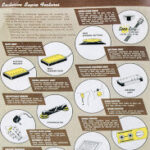Learning guitar can be an amazing journey, but it often comes with its share of frustrations. Have you ever felt lost when a tutorial assumes you understand guitar diagrams or charts? It’s a common hurdle for beginners – feeling like you’re missing a foundational piece of the puzzle. It’s similar to job hunting and seeing “entry-level” positions requiring years of experience – we’ve all been there!
The good news is that mastering guitar becomes significantly easier once you learn to decipher chord charts and tabs. These visual systems are the secret language of guitar music, used by players worldwide to understand and share songs. Learning to read them is like unlocking a vast library of music. Suddenly, countless songs become accessible, and you can start learning your favorites independently.
This guide will walk you through understanding both chord charts and guitar tabs, providing you with the essential knowledge to start playing songs on your own. Remember, learning any new skill takes time and patience. Be kind to yourself, practice consistently, and soon you’ll be confidently reading guitar chord tabs and more!
What Are Guitar Chord Charts?
Guitar chord charts are beginner-friendly diagrams designed to simplify the process of learning chords. Think of them as visual maps for your fingers on the guitar fretboard. When you encounter a chord you’re unfamiliar with, a chord chart instantly shows you where to place your fingers to form the correct shape. They are an invaluable tool for expanding your chord vocabulary and quickly grasping new chord voicings.
How to Read Guitar Chord Charts: Decoding the Diagram
Reading a chord chart is simpler than you might think. Imagine holding your guitar in front of you, looking down at the fretboard from the headstock towards the body. This is essentially the perspective of a chord chart. The chart represents a small section of the guitar neck, typically starting at the nut or a specific fret.
Let’s use the fundamental “A Major” chord as our example to illustrate how chord charts work.
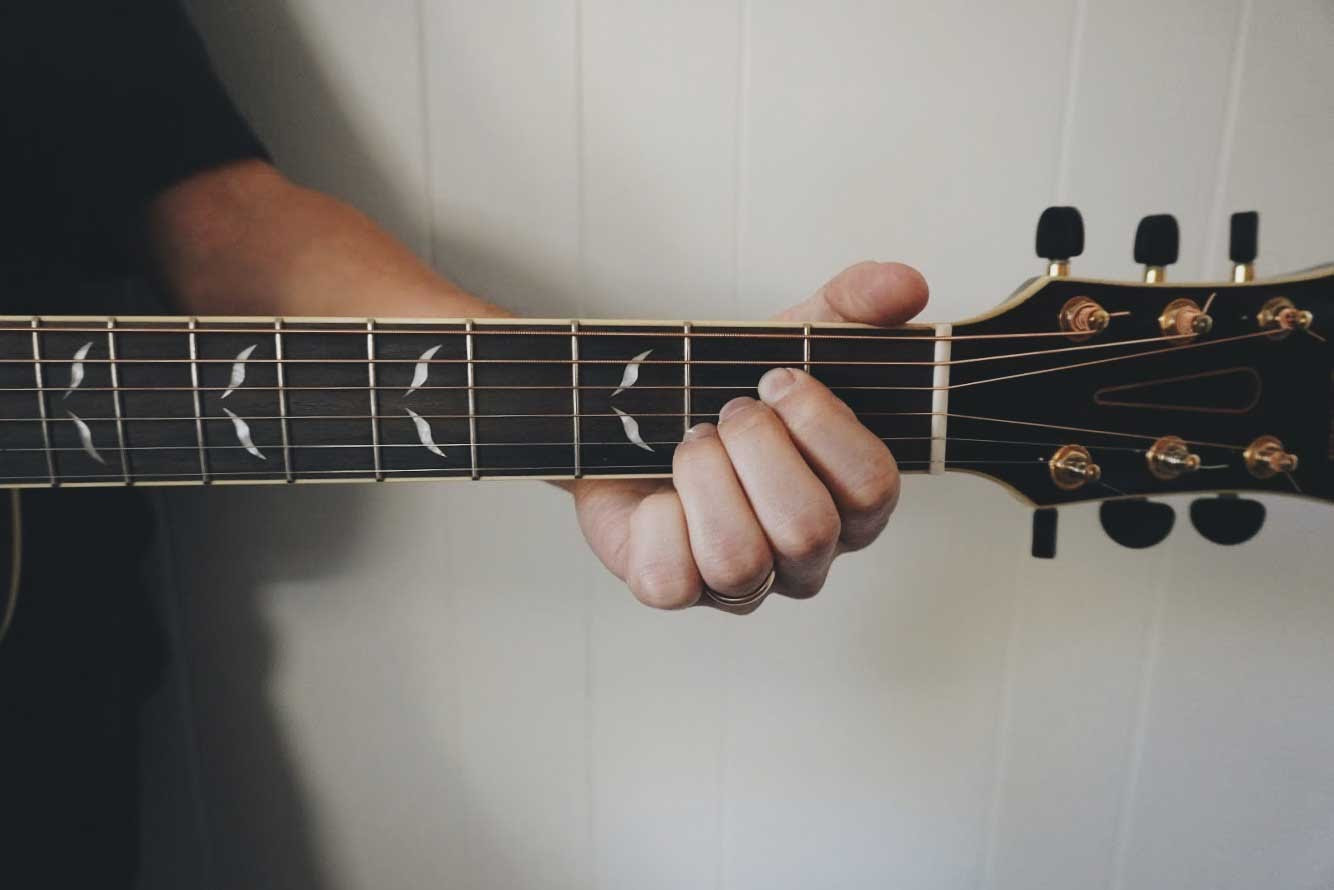
This is how an “A Major” chord looks when played on the guitar. Now, let’s see how this translates into a chord chart diagram.
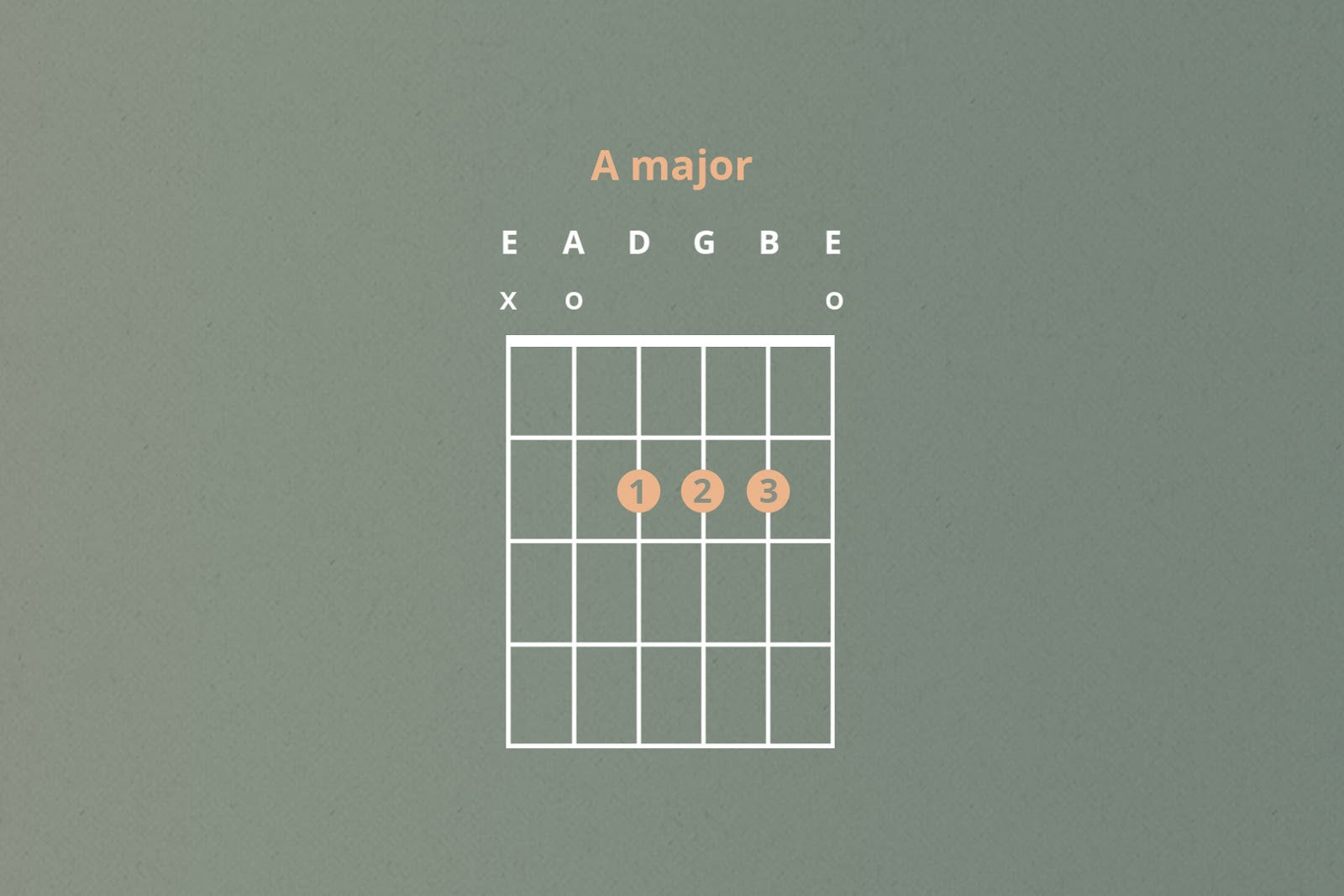
Let’s break down each element of this “A Major” chord chart to understand its components:
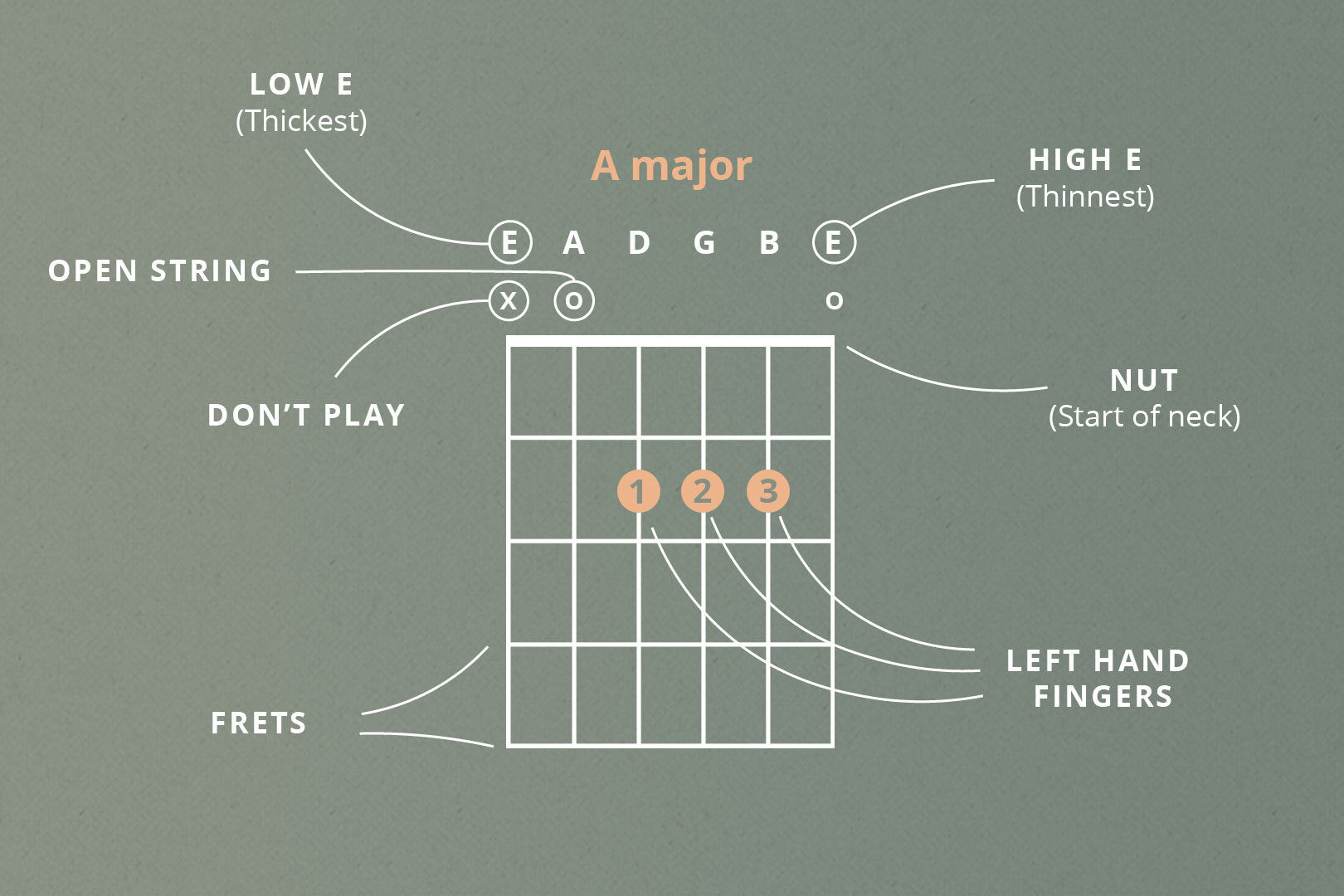
- Vertical Lines: Guitar Strings: The vertical lines in a chord chart represent the guitar strings. The leftmost line corresponds to the thickest string, the Low E string (6th string), and they proceed in order to the rightmost line, which is the thinnest string, the High E string (1st string). Think of it as reading from the bass strings to the treble strings, left to right.
- Horizontal Lines: Guitar Frets: The horizontal lines symbolize the frets on the guitar neck. The topmost horizontal line usually represents the nut (the white bar at the top of the fretboard), or sometimes the first fret depending on the chart’s representation. Subsequent horizontal lines below represent the frets moving down the neck towards the guitar’s body.
- “X”: Muted String: An “X” symbol positioned above a string at the top of the chart indicates that this string should not be played or should be muted with your fretting hand. In the “A Major” example, there are “X”s above the Low E and High E strings, meaning you should avoid strumming or playing these strings when playing this chord.
- “O”: Open String: An “O” symbol above a string at the top of the chart signifies an “open” string. This means you should play this string without pressing down on any fret. In the “A Major” example, there’s an “O” above the A string, indicating that you should play the A string open.
- Dots: Finger Placement: The dots placed on the intersection of horizontal and vertical lines indicate where you need to place your fingers on the fretboard. For the “A Major” chord, the dots are on the D, G, and B strings, all on the second fret. This tells you that you need to press down these strings at the second fret to form the chord.
- Numbers in Dots: Finger Numbers: The numbers inside or next to the dots often represent which finger of your fretting hand you should use to press down the string. “T” stands for thumb (rarely used in chord charts), “1” is your index finger, “2” is your middle finger, “3” is your ring finger, and “4” is your pinky finger. While finger suggestions are helpful, especially for beginners, they are just suggestions. Focus on accurate finger placement to produce a clean sound, and adjust fingering as you become more comfortable and develop your own preferences.
What Are Guitar Tabs (Tablature)?
Now that you’re comfortable with chord charts, let’s explore guitar tablature, commonly known as “tabs.” Guitar tabs are a simplified form of musical notation specifically for guitar (and other fretted instruments). Think of them as a visual representation of the guitar strings and frets, showing you exactly where to play notes on the fretboard to play melodies, riffs, and even chords within songs. Tabs are incredibly useful for learning specific song parts, solos, or melodies that might be challenging to learn by ear alone. They bypass the complexities of standard musical notation, making learning songs more accessible to guitarists of all levels.
How to Read Guitar Tabs: Decoding Tablature
Reading guitar tabs is quite intuitive once you understand the basic layout. Instead of representing musical notes on a staff like traditional sheet music, tabs use lines to represent the guitar strings and numbers to indicate which fret to play on each string.
Let’s use the well-known tune “Happy Birthday” as an example to understand how to read a simple guitar tab.
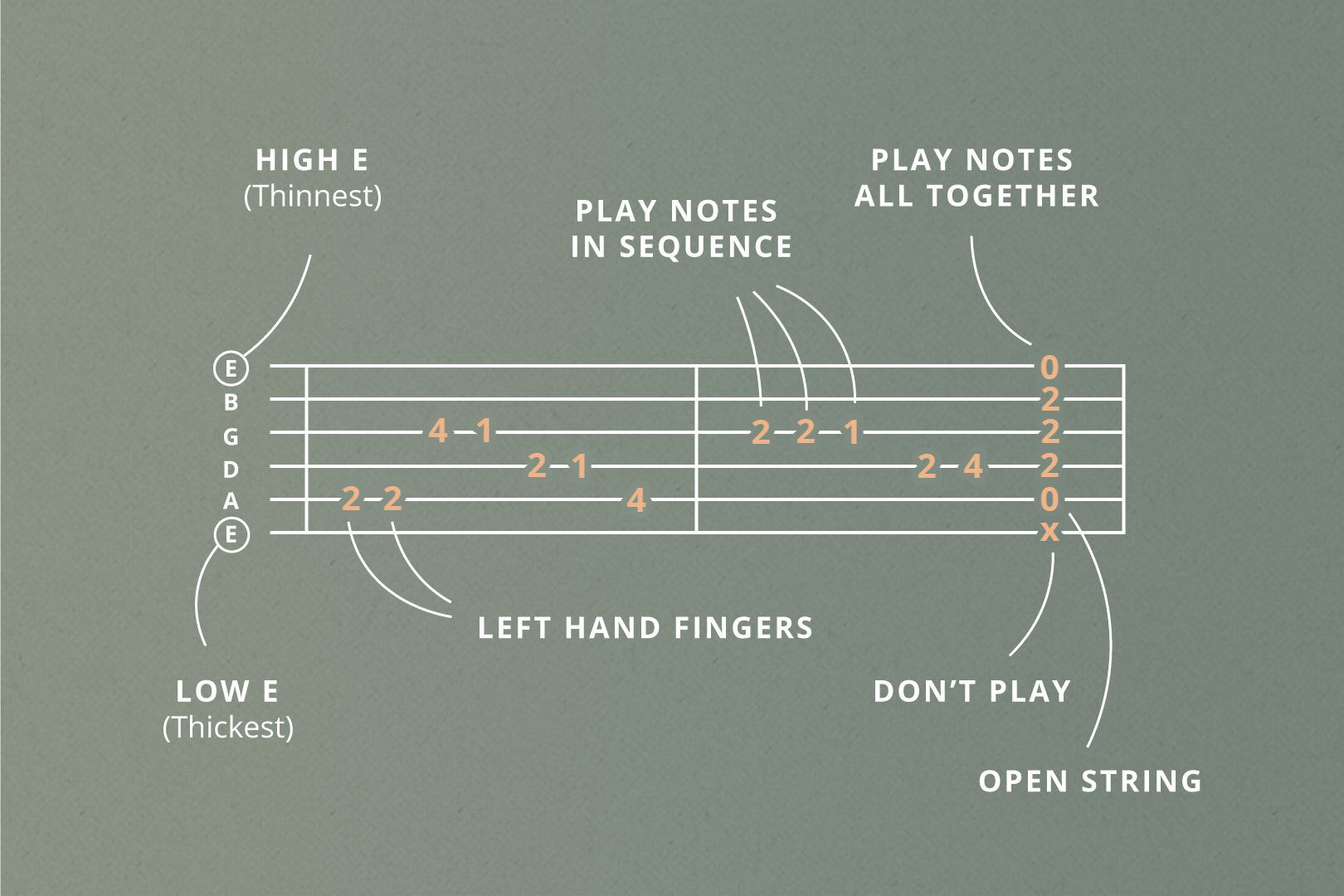
Let’s break down the components of this “Happy Birthday” tab:
- Horizontal Lines: Guitar Strings (Reversed Order): The horizontal lines in a guitar tab represent the guitar strings, but in reverse order compared to chord charts. The top line in a tab corresponds to the highest pitched string, the High E string (1st string). Moving downwards, the lines represent the B string, G string, D string, A string, and finally, the bottom line represents the lowest pitched string, the Low E string (6th string). It’s crucial to remember this reversed order to avoid playing the wrong notes!
- Numbers on the Lines: Frets to Play: The numbers written on the horizontal lines indicate which fret to press down on that particular string. For example, the first number in the “Happy Birthday” tab is “2” on the A string line (second line from the bottom). This means you should press down the A string at the 2nd fret. A “0” indicates an open string.
- Reading Order: Left to Right: You read guitar tabs from left to right, following the chronological order of the numbers. The sequence of numbers tells you the order in which to play the notes. So, in the “Happy Birthday” example, you start by playing the note indicated by the first number, then move to the next number to the right, and so on.
- Vertical Alignment: Simultaneous Notes: When you see numbers stacked vertically in a tab, it means you play those notes at the same time. This often indicates a chord or a harmonic interval. At the end of the “Happy Birthday” tab, you see numbers stacked vertically: “2” on the D string, “2” on the G string, and “2” on the B string. This indicates that you should play these notes simultaneously, which, in this case, forms part of an A chord.
- “X” and “O” in Tabs: Similar to chord charts, “X” in a tab generally means to mute a string or avoid letting it ring, while “O” means to play the open string and let it ring out. However, “X” is less commonly used in standard tabs for single-note melodies and is more frequently seen in rhythm tabs representing strumming patterns.
While tabs might appear slightly more complex than chord charts initially because they represent specific song parts, they are quite straightforward to learn with a bit of practice. Even a basic understanding of tabs can be incredibly helpful in deciphering tricky sections of songs, especially fast solos or complex riffs where the notes are difficult to discern by ear. The more you practice reading and using tabs, the easier and more intuitive they will become.
Chord Charts vs. Tabs: Which Should You Use?
Both chord charts and tabs are valuable tools for guitarists, but they serve different purposes:
- Chord Charts: Best for learning chords quickly and understanding chord shapes. Ideal for beginners learning basic songs and expanding their chord vocabulary. Chord charts are excellent for rhythm guitar playing and songwriting when you need to quickly visualize chord fingerings.
- Guitar Tabs: Best for learning specific songs, melodies, riffs, and solos. Essential for learning the nuances of how a song is played, including note-for-note transcriptions. Tabs are invaluable for lead guitar playing and learning complex musical passages.
Often, chord charts and tabs are used together. You might see chord charts above lyrics to indicate chord changes in a song, while tabs are used to notate instrumental parts, solos, or specific riffs within the same song.
Tips for Mastering Chord Tabs and Charts
- Start Simple: Begin with basic chord charts and simple tabs for beginner songs. Don’t try to tackle complex tabs or chord diagrams right away.
- Practice Regularly: Consistent practice is key. Even short, focused practice sessions will help you become more comfortable reading and interpreting charts and tabs.
- Use Online Resources: Websites like ultimate-guitar.com, songsterr.com, and others offer vast libraries of chord charts and tabs for almost any song imaginable.
- Combine with Ear Training: While charts and tabs are visual aids, try to also train your ear to recognize chords and melodies. This will enhance your musicality and make you a more well-rounded guitarist.
- Be Patient: Learning to read chord charts and tabs takes time. Don’t get discouraged if it feels confusing at first. Keep practicing, and it will become second nature.
Conclusion
Learning to read guitar chord charts and tabs is a fundamental step in your guitar journey. These visual systems are your keys to unlocking a world of music, allowing you to learn songs independently, understand guitar music notation, and progress as a guitarist. By understanding the components of chord charts and tabs and practicing regularly, you’ll empower yourself to learn countless songs and take your guitar playing to the next level. So, grab your guitar, find some chord charts and tabs for your favorite songs, and start exploring! The world of guitar music awaits you.

